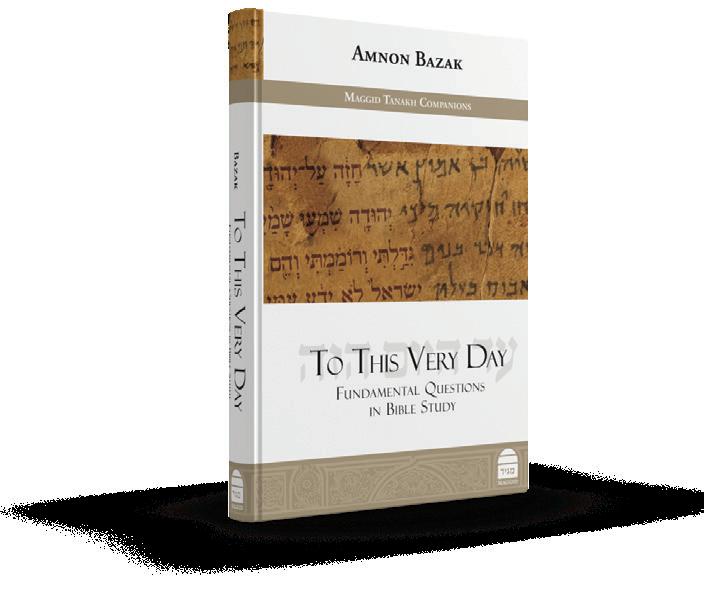
12 minute read
Immersion of Digital Kitchen Appliances Rabbi Ezra Friedman
PAGE
BY RABBI EZRA FRIEDMAN Director, The Gustave & Carol Jacobs Center for Kashrut Education
Advertisement
Immersion of Digital Kitchen Appliances
The previous article discussed the obligation to tovel (immerse) electrical appliances in a mikvah. Many basic electrical appliances such as water-urns, sandwich or waffle makers and hand blenders should be immersed in a mikvah. This article will take a look at the requirement to immerse digital appliances.
Digital appliances are a more complex category with regard to immersion due to the potential damage that may be caused to the screen or chips found in the device. Some digital products contain removable parts which require immersion. For example, many oil-free compact fryers have a bottom compartment (similar to a drawer) which may be immersed. In this case, the digital screen will not be immersed in water. However, many newer multi-cookers or bread makers cannot be taken apart, and the same would apply to advanced digital water dispensers.
In a case where it is quite possible that the utensil would be seriously damaged, it would seem that the utensil should not be immersed in a mikvah. However, this is not so clear. According to the Darchei Teshuva (120:112), the utensil should be given to a non-Jew as a gift and the Jew may then borrow it for a long period of time (similar to a case where a utensil is too big for immersion). This option is problematic according to the Taz (YD 120:18) and Be’er Moshe (7:57), who consider this an inappropriate loophole. Another option is to sell part of the utensil to a non-Jew.

The OU Israel Gustave & Carol Jacobs Center for Kashrut Education was created to raise awareness and educate the public in all areas of Kashrut in Israel. Rabbi Ezra Friedman, a Rabbinic Field Representative for the OU is the Center's director.
However, in a private home this may be difficult, since the non-Jew might not understand this legal act and does not gain any benefit from the utensil.
Rav Shlomo Zalman Auerbach (as quoted in Sefer Tevilat Keilim p.65) recommends having a Jewish electrician dismantle and reassemble an electric piece. The basis of Rav Auerbach’s ruling is that a utensil made by a Jew does not require immersion. If a Jewish electrician were to dismantle the appliance it would be considered “manufactured” by a Jew. Rav Auerbach emphasizes that the electrician must fix something intricate. But simply removing the cord and reinstalling it would not be sufficient (see Sefer Hakshrut page 117).
Rav Shmuel Wosner is quoted (ibid) as saying that Rav Auerbach’s ruling is also somewhat questionable. In addition, the Chochmat Adam (73:13) rules that in order to consider the utensil “manufactured”
by a Jew, he must annul its ability to be a receptacle, whereas this normally destroys the appliance.
Rav Hershel Schachter (posek for the OU) has a different approach to this topic. Rav Schachter holds that in a situation where the utensil will break, it would seem logical that Chazal (our Sages) would not have required immersion at all. This can be compared to one who owns a utensil together with a non-Jew in a partnership. As mentioned in previous articles, the Rema (YD 120:11) cites the ruling of the Issur V’heter that in such a case there is no mitzvah of immersion, since as soon as one removes the utensil from the mikvah, it would become obligated in immersion again (since it still belongs partially to the non-Jew). In that case, since it is not possible to immerse, it may be used without immersion. This rationale can be applied to a utensil that could break, such as a digital appliance.
BY RABBI SAM SHOR Program Director, OU Israel Center
In our sedra this week, Hashem instructs Moshe to build the Mishkan, a sacred space for Hashem’ s presence among the Jewish people. The opening verses of Parshat Teruma set forth the mandate that each member of Klal Yisrael must participate by contributing to the enterprise of the Mishkan’s constructionvayikchu li teruma -take and present for me a gift.
The Great Chasidic Sage, Reb Simcha Bunim of Peshischa, zy’a explained the intention behind our verse - vayikchu li teruma - take and present for me a gift as follows:
Every individual desires that they should indeed themselves be ‘gift worthy’. Each person strives to ascend to a high and holy state of consciousness, and only when we have achieved that heightened consciousness are we worthy to experience and intuit the gift of the divine presence which resides within each of us.
The Tiferet Shlomo, the Rebbe of Radomsk, zy’a, clarifies this point: During those sacred moments when a person expresses their dedication, when they commit to contribute to the needs of the community and begin to see the innate holiness within one another and within each member of the community, then the divine presence is felt in the most palpable way.
Rabbi Gedalia Schorr zt’l, adds, that a person must therefore have a strong desire for Torah, and give their heart fully toward Torah, and with this desire, it becomes possible to achieve and feel the divine presence resting within each of us.
Yehi Ratzon, May each of us merit to feel ‘gift worthy’ and to experience the awesome gift of Hahsem’s presence and love each and every moment.

New & Hot Off the Press from Maggid Books
ESTHER Power, Fate, and Fragility in Exile Dr. Erica Brown



TO THIS VERY DAY Fundamental Questions in Bible Study Rav Amnon Bazak
NAHUM, HABAKKUK AND ZEPHANIAH Lights in the Valley Rav Yaakov Beasley


PREPARE MY PRAYER Recipes to Awaken the Soul Rav Dov Singer
Now available at local Jewish bookstores, the OU Israel Center, and at www.korenpub.co.il
Get free shipping in Israel when you order directly from www.korenpub.co.il – orders must be over 200nis.
GOLDSCHEIDER
Mirroring the Mizbeach
The founding father of the Chassidic movement, the holy Baal Shem Tov (1698-1760), was the first to introduce the custom on Shabbat and special occasions to join together as a community around the table of the Rebbe. These gatherings became affectionately known as a tisch, the yiddish word for table.
Why, specifically, was the term, tisch, ‘table” chosen? Perhaps, the answer can be traced to this week’s parsha.
Remarkably, the Talmud equates the mizbeach found in the Beit Hamikdash with the table where a Jew dines: “During the period that the Holy Temple stood, the altar (mizbeach) would atone for a person, now that the Temple is destroyed, it is a person’s table that atones for him” (Chagigah 27a).
Rashi commenting on this passage says that the act around our tables which activates Hashem’s mercy is hachnasat orchim; when we invite and feed guests.
‘table manners’. The Gemara (Sanhedrin 92a) states, “That whoever does not leave some bread on the table at the meal’s conclusion will not see a sign of blessing.” This halacha is codified by the Shulchan Aruch (Orach Chayim 180:2). The Mishnah Berurah commenting on this law suggested that the reason for this halacha is so that there will always be something remaining for the poor.
Our Sages suggest a fascinating parallelism between the mizbeach and our dining room tables. The Shulchan Aruch (Orach Chayim 180:5) writes that it is customary to cover up knives during birkat hamazon. The Beit Yosef in his commentary on the Tur says that it is based on the association with the mizbeach. The verse says, lo tanif aleha barzel - which relates to not using metal in the building of an altar: “And it shall be when you pass over the Jordan...and there you you build an altar to Hashem, an altar of stones; you shall lift up no iron tool upon it (Devarim 27:5).
This idea is expanded upon in the Beit Yosef: “Iron shortens the life of man, the mizbeach lengthens the life of man. Therefore a knife should not be used in building the mizbeach and should also not sit upon our tables.” It is for this reason that customarily knives are covered or removed at a time when we have a
Perhaps the most well known example by which we signify our tables emulating the mizbeach is via the practice of placing salt on the table and adding salt to bread. The Re”ma (Orach Chayim 167:5) writes that it is a mitzvah to place salt on the table “since the table resembles the altar and all the sacrifices had salt brought with them.” The Aruch HaShulchan (167:12) adds that all God fearing people follow this custom. This notion is based on the pasuk, “On all your offerings you shall offer salt.”
The Mishna in Pirkei Avot also makes a correlation between our table and the mizbeach: “If three have eaten at the same table and have spoken words of Torah there, it is as if they have eaten for the table (mizbeach) of the Omnipresent (Avot 3:3).
The Seforno (1475-1550) explained this mishna simply: Just as the offerings were meant to serve Hashem, so too our tables can be a setting for avodat Hashem, service to Hashem. (Seforno Commentary on Avot 3:3).
Rabbi Chaim Volozhin (1749-1821) offered a memorable insight on this mishna: He suggested that we can easily imagine how our tables and food resemble the mizbeach. However, what at our tables symbolizes the fire, which was essential to the offerings? He offered a simple solution: The words of Torah that are shared are likened to fire; as the pasuk says “Is not my word like fire, declares Hashem…” (Yirmiyahu 23:29). (Ruach
Chayim Avot 3:3). Words of Torah burn away the physicality and the hedonistic inclination and uplift the act of eating to a spiritual plain.
All the examples cited above assume that the correlation between mizbeach and our tables refer specifically to the outer altar of the Temple. However, there were two altars in the Temple: the outer altar and additionally the inner altar, referred to as the mizbeach hazahav or haketoret, ‘the golden or spice- burning mizbeach’.
In fact, the famed Chassidic master, Rebbe Zvi Elimelech of Dinov (1783-1841) in his work Agra D’Pirka (quoted by Rabbi Pinchus Friedman, ‘Shvilei Pinchas’, T'rumah 5773), argues that our tables should replicate the mizbeach haketoret, the spice burning mizbeach. Why so? He makes the following suggestions:
Firstly, the Rebbe says that a remez, a hint, to this is embedded in the Torah itself: Of the eleven spices that made up the ketoret, only four are mentioned in the pesukim explicitly. They are shachelet, levonah, chelbona, and nataf. The rashei tevot, the first letters, of these words spell out ןחלש shulchan - an allusion, according to the Rebbe, to our tables today.
But beyond this remez, on a more conceptual level, there is profound symbolism concerning the spice-burning mizbeach, which can be appreciated when we understand its daily offering of the ketoret. The Hebrew word ketoret literally means ‘bonding’ or ‘unifier’. The ketoret consisted of ten sweet smelling ingredients and one foul smelling ingredient known as the chelbonah. Symbolically, the larger group, which were sweetly fragranced, embraced the eleventh and it was thereby uplifted.
Interestingly, along these same lines, the Talmud states that the ketoret atoned specifically for the sin of lashon hara. The mizbeach haketoret which exemplified the notion of brotherhood and fellowship offset the corrosive force of lashon hara, a sin that represents a force that generates divisiveness and descension.
A table, where we share meals with one another, is a venue for social interaction. Unfortunately, it is not uncommon that we stumble and use that setting in a way where conversation is harmful to others by speaking lashon hara. How do we make amends or ‘atone’ for such errors? We right this wrong when we elevate our dining experience by refraining from speaking or listening to lashon hara and engage in conversation that is positive, meaningful, and even includes words of Torah learning.
One may ask, “Which of the two altars should one have in mind when sitting down to a meal?” The answer is simple. It need not be one or the other. Apparently, we should have both in mind.
Rabbi Pinchus Friedman shlit”a, an illustrious contemporary teacher of Chassidut, quotes the Ben Ish Chai (Od Yosef Chai, Parshat T'rumah) in the name of the eminent Kabbalist, the Rashash, Rav Shalom Sharabi zt”l, who advises that a person should learn at his table, during the meal, a passage pertaining the ketoret
(Parshat Haketoret) and a chapter related to the sacrifices (Eizehu Mikoman). It is evident according to these sages that we conjure up in our minds thoughts of both altars. (‘Shvilei Pinchas’, Parshat T'rumah 5773).
Rabbi Yosef Dov Halevi Soloveitchilk zt”l, who gave much thought to the halachot and religious meaning behind the way we eat as Jews, pointed out the fact that it is actually very peculiar that the Talmud make a parallel between the mizbeach and our own tables where we eat. After all, the mizbeach was used to offer sacrifices to God - around our tables the food is directed solely for human consumption! Ostensibly are they not opposites? He answered that Judaism offered the world a spiritual breakthrough in the way one dines: “The meal is redeemed by it becoming a divine service.” (Jewish Table Etiquette, Rav Ezra Bick, VBM Shiur).
We can now better understand why Chassidut coined the phrase tisch, table, for their joyous gatherings. They spotlighted the special spiritual potential which can be accessed in this setting. Sitting around a table that is chesed oriented, infused with sanctity and Torah learning, brings one Jew closer to his friend and brings each participant closer to the Creator. Undoubtedly, it can be stated: “The table can be transformed into a mizbeach.”

Mortgage RATES at historic LOWS for refinance & purchase
Special rates up to 75% LTV: 30 year 3.85% 15 year 2.90% 10 year 2.75% For well qualified borrowers Purchase / Refinance Rates (Non-inflation linked)*
02-625-2555 firstisrael.com 60 King George, Jerusalem 3 Aluf Kalman Magen, Tel Aviv
*Rates are for quali ed borrowers and are current as of the printing of this advertisement but are subject to change. Quoted rates do not represent an offer and are for illustrative purposes only.










